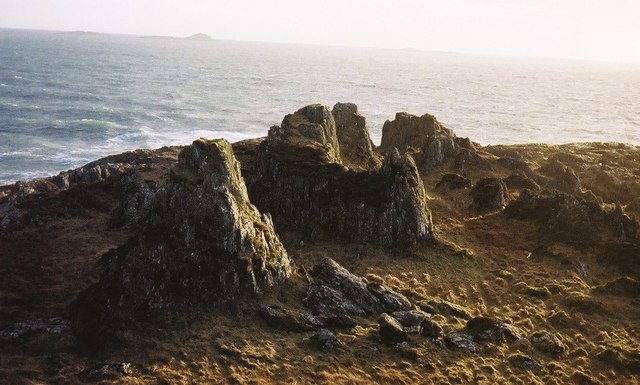Late every May, hundreds of walkers complete the Ultimate Challenge: a sociable walk from the West Highlands to the east coast of Scotland, starting and ending at a number of permitted points. Conceived by Hamish Brown, it is now organised and promoted by The Great Outdoors magazine, and so has now become known, with unavoidable tautology, as the TGO Challenge.
Loch Nevis - on a potential route for the TGO Challenge:

Every year, thousands complete the English coast to coast, from St Bees Head to Robin Hood's Bay. An invention of Alf Wainwright, this route is fixed but has no organiser: it is there for you to walk whenever you feel like doing it, and at your own pace.
Ennerdale Water on the Coast to Coast, courtesy Cumbrians Against Flouridation:

One might think that it would be easy in the Highlands to create a coast to coast route to surpass England's coast to coast. But thanks to geography and Alf Wainwright's cunning, this is harder than it seems. The English coast to coast starts at the beach and headland of St Bees Head: goes through the Lakes, traverses the Pennines, has its only dull section crossing the Vale of York, and finishes with a high-level traverse across the North York Moors and a walk down the cliff-girt North Yorkshire to the beautiful hamlet of Robin Hood's Bay. The Scottish coast to coast routes often start more spectacularly, for example on the ridges of Kintail, the beaches of Arisaig or the roadless coasts and hills round Knoydart, but these walks all peter out into trudges across miles of dull south-eastern Grampian heather moor, with a whole day of road walking to end at places like the working towns of Montrose or Arbroath. The Coast to Coast, it seems, surpasses the TGO Challenge for sustained interest.
I was surprised at this. Surely there is a route of sustained interest and quality across the breadth of Scotland? I got my large scale maps out and started plotting. I would begin at Big Sand near Gairloch - a beautiful bay with exciting hill and sea views - go through the lovely village of Gairloch and pass its beach,
Gairloch Beach:

walk through the native forest of Kerrydale and the passes under the frozen giants of Torridon,
Loch Clair and Liathach:

head up the Golden Valley to the spacious backcountry around Beinn Dronaig,
At the other side of the Golden Valley:

visit the veriginous Falls of Glomach, head round into Glen Affric,
Glen Affric:

and arrive in Fort Augustus via the Plodda Falls and Glen Morriston.
But after Fort Augustus the route wasn't clear. The Corrieairack pass and its attendant electricity pylons, but then what? There are a number of fine Cairngorm and Mounth passes to choose from, but it is hard to avoid the heathery trudges in the Eastern Grampians. And the route was dog-legged too: barely moving far from the west coast, the route from Gairloch to the Falls of Glomach is a southward excuse to visit lots of good scenery, before reluctantly veering east at the last feasible moment for the rest of the trip. Gairloch to Fort Augustus (or Fort Augustus to Gairloch) would be a very good trip. But it wasn't a coast to coast, it was just a coast. Wainwright was still winning.
And then it hit me. Use the lie of the land, don't go against it. Something I'd read - Hamish Brown again I think - about looking down the Lairig Eilde between the Buachailles, about it being 'like a gunsight' as it lined up with another pass across the Blackwater Dam.
The Buachailles on the left with the pass of Lairig Eilde between:

There are loads of fault lines in the Highlands, the Great Glen being the most obvious. But I'd always been intrigued by the geological patterns in Lorn and Knapdale. I traced my finger back from the Buachaille. It goes down fjord-like Loch Etive, past Loch Nant and its majestic view of Ben Cruachan, through the pre-history rich valley of Kilmartin (with my favourite stone circle, Templewood), past the beaver woods of north Knapdale to the long finger of land that ends at Keilmore and Rubha na Cille. I'd cycled this peninsula one day down to the ancient church at Keilmore. On a mellow September day of radiant soft light it was one of the most haunting, beautifully atmospheric places in the Highlands. I looked up Rubha na Cille on
geograph. The land ended in exclamation marks of stone.
At Rubha na Cille, courtesy Ian Paterson:

I traced my finger forward from the Buachaille down the gunsight of the fault line. Great backcountry across Rannoch Moor: Loch Ghulabain, Binnein Shuas, Glen Markie. And oh! The Findhorn, Scotland's most beautiful river. A place I've not yet visited, yet since reading
White River it feels like my duty to do so.
River Findhorn, from Google:

My mind was made up: Following this fault line across the Grampians was to be *my* Coast to Coast/TGO Challenge.
Now I just need to take the time off work to walk it.


























